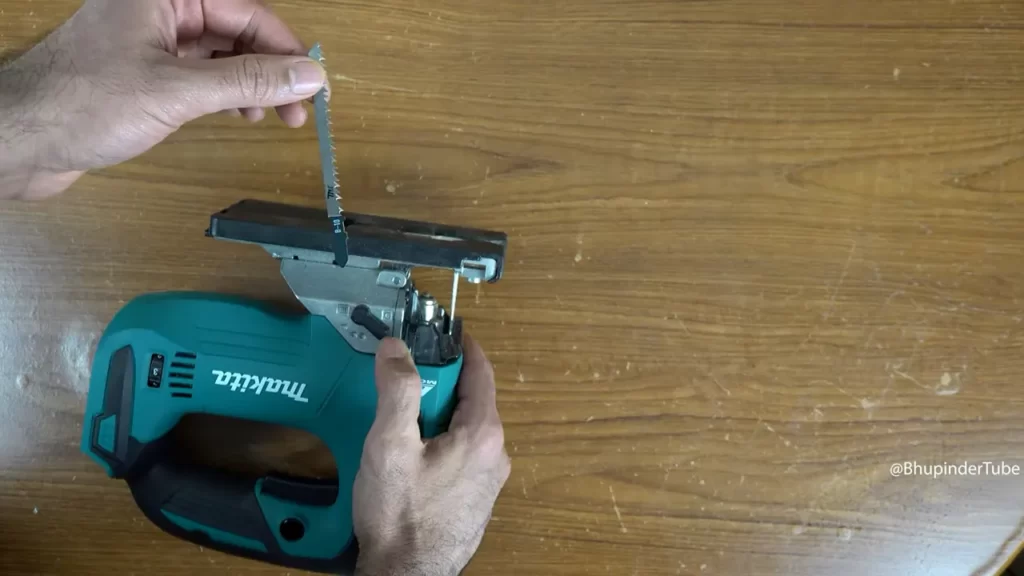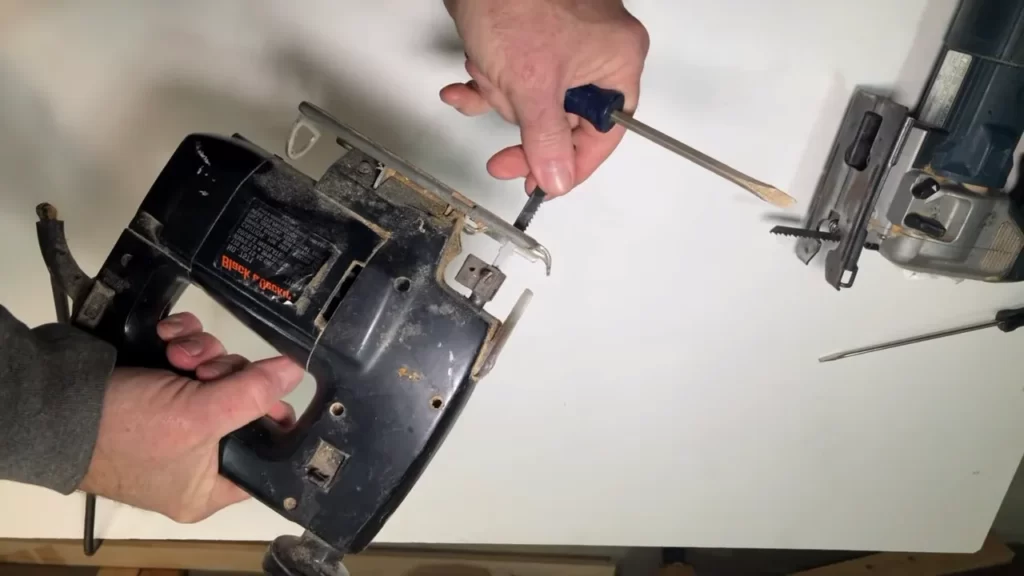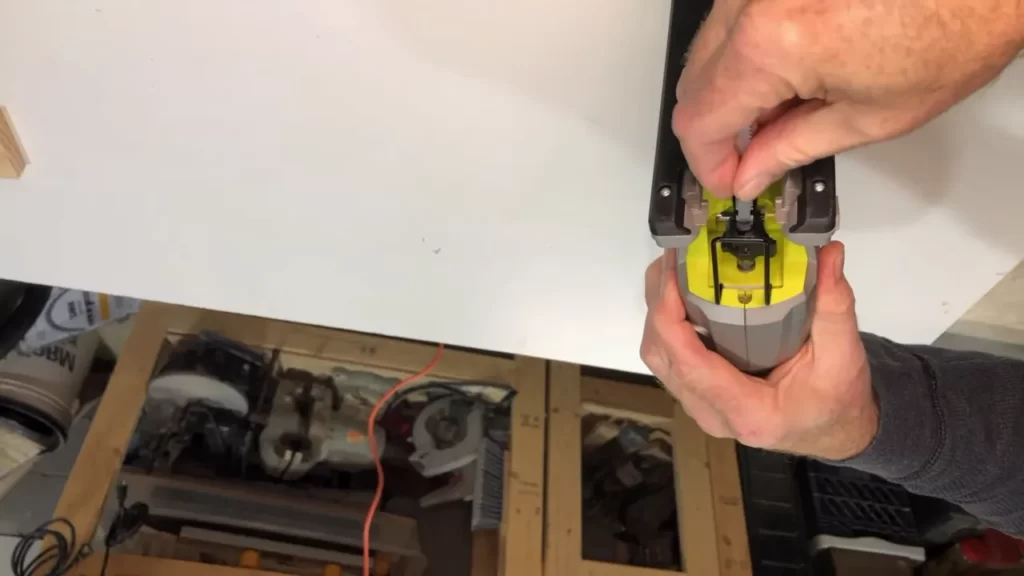To install a jigsaw blade, follow these steps: insert blade into the jigsaw, align it properly, and tighten the blade clamp securely. We will discuss the process of installing a jigsaw blade in detail, providing you with a step-by-step guide so that you can easily and effectively complete this task.
Installing a jigsaw blade correctly is crucial in order to ensure smooth and accurate cutting. By following the instructions below, you will be able to quickly and efficiently install a jigsaw blade, allowing you to use your jigsaw to its full potential.

So, let’s dive right in and learn how to install a jigsaw blade!
Choosing The Right Jigsaw Blade
When it comes to installing a jigsaw blade, choosing the right blade is crucial for achieving the desired results. There are several factors to consider when selecting a jigsaw blade:
- Type of Material: Different jigsaw blades are designed for specific materials such as wood, metal, or plastic. Ensure you choose a blade that is suitable for the material you will be working with to get the best performance.
- Teeth Per Inch (TPI): The TPI determines the cutting speed and the smoothness of the cut. Blades with a higher TPI are ideal for cutting intricate shapes or curves, while blades with a lower TPI are better for rough cuts.
- Tooth Configuration: Jigsaw blades come in different tooth configurations, including straight, tapered, or ground. Each configuration is suited for specific cutting tasks, so choose one that matches your requirements.
- Blade Material: Blades can be made from various materials such as high-speed steel (HSS), bi-metal, or carbide-tipped. Consider the durability and cost-effectiveness of the blade material before making a selection.
By understanding the different types of jigsaw blades available and considering these factors, you can make an informed decision and ensure successful installation of the blade for your jigsaw.
Step-by-step Guide To Installing A Jigsaw Blade

Preparing your jigsaw for blade installation: Before you get started, ensure that the jigsaw is unplugged and powered off. Inspect the jigsaw to locate the blade holder and release mechanism, which may vary depending on the make and model. Familiarize yourself with the specific instructions in the jigsaw’s manual, if available.
How to safely remove the old blade: To remove the old blade, locate the blade release mechanism and engage it. Carefully remove the old blade from the blade holder, ensuring not to touch the sharp edges. Dispose of the old blade safely.
Aligning and inserting the new jigsaw blade: Take the new jigsaw blade, ensuring it is compatible with your jigsaw. Align the teeth of the blade with the direction of the sawing motion. Insert the blade into the blade holder, making sure it is securely in place. Release the blade release mechanism to lock the new blade.
Tips And Tricks For Proper Blade Installation
Installing a jigsaw blade properly is crucial for achieving accurate and efficient cuts. To ensure a secure installation, it is essential to tighten the blade firmly. A loose blade can lead to vibrations and imprecise cuts. Make sure the blade is oriented correctly for optimal cutting performance. Most blades have directional arrows indicating the proper orientation. Always follow these guidelines to prevent cutting errors and maximize the lifespan of the blade.
Maintaining And Replacing Jigsaw Blades

Regular maintenance and timely replacement of jigsaw blades are essential to ensure optimal performance and longevity. To maintain the blade, it is important to keep it clean and free from rust and debris. This can be achieved by wiping it with a dry cloth after each use and using a rust-inhibitor spray to prevent corrosion. Keeping the blade sharp is also crucial, as dull blades can result in poor cutting quality and exert unnecessary pressure on the saw motor. Signs that indicate it’s time to replace a jigsaw blade include excessive wear and tear, chipped or broken teeth, and reduced cutting efficiency. When disposing of used jigsaw blades, it is important to follow safety guidelines to prevent any injuries. Make sure to wrap the blade in a protective material and place it in a designated container or dispose of it at a local recycling center.
Frequently Asked Questions On How To Install A Jigsaw Blade
What Direction Do Teeth Go On A Jigsaw Blade?
The teeth on a jigsaw blade face downward, allowing the blade to cut through material as it moves up and down.
How Do You Install A Cutting Blade?
To install a cutting blade, follow these steps: 1. Locate the blade attachment point on the tool. 2. Remove any existing blade by loosening the retaining bolt. 3. Align the new blade with the attachment point. 4. Tighten the retaining bolt securely.
5. Test the blade for proper function and tighten if necessary.
How Do You Put A Blade In A Black And Decker Jigsaw?
To insert a blade in a Black and Decker jigsaw, follow these steps: 1. Unplug the jigsaw for safety. 2. Open the blade clamp by turning the screw counterclockwise. 3. Insert the blade into the blade clamp, teeth facing forward. 4.
Tighten the screw by turning it clockwise until secure. 5. Plug in the jigsaw and it’s ready to use.
Conclusion
From learning about the different types of jigsaw blades to understanding the correct installation process, this guide has provided you with all the necessary steps to successfully install a jigsaw blade. By following these instructions, you can ensure that your jigsaw operates efficiently and safely.
Now that you know how to install a jigsaw blade like a pro, you can confidently take on your next woodworking project with ease. Happy woodworking!
